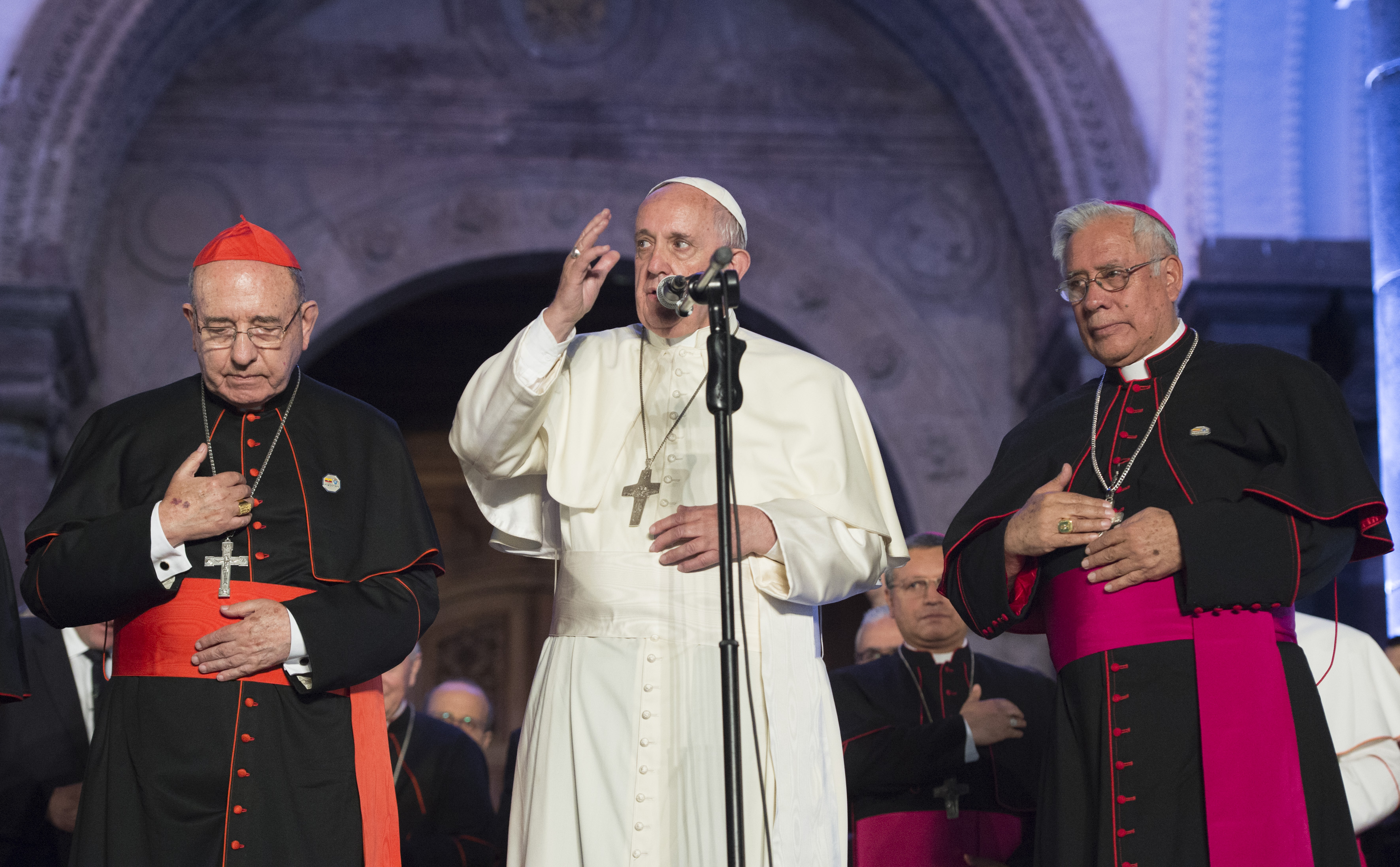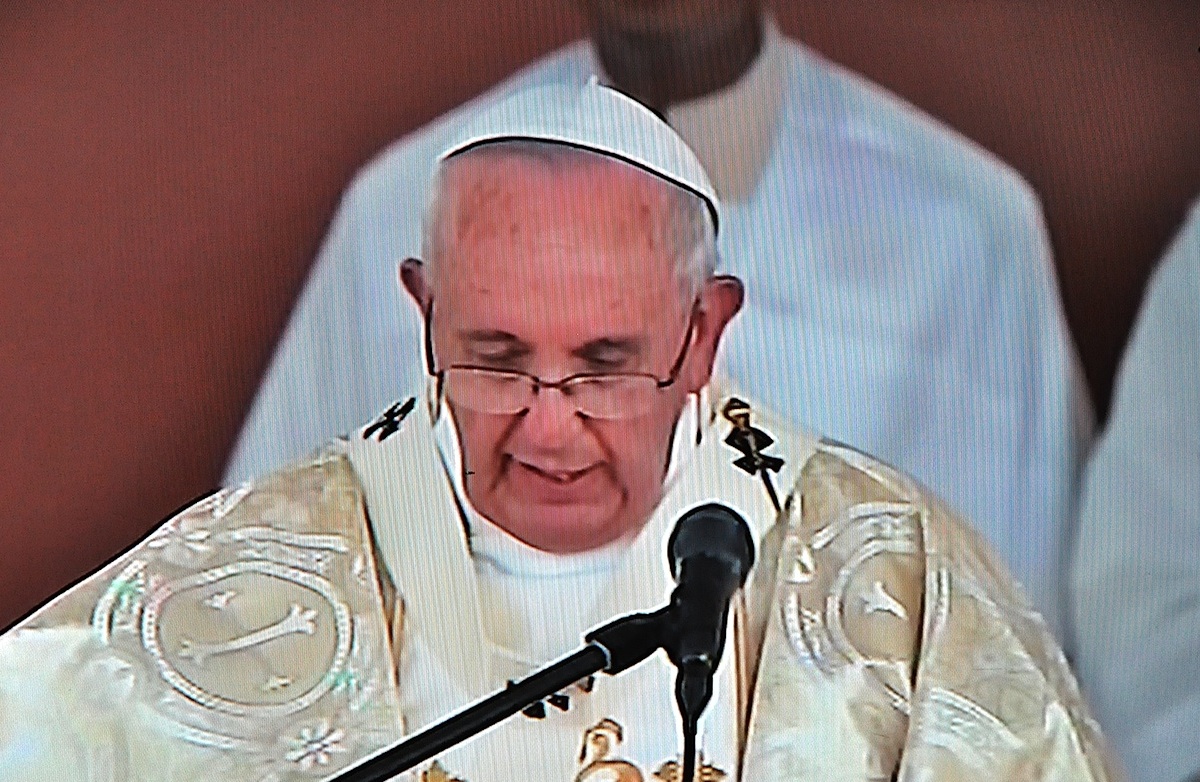Answered by Legionary of Christ Father Edward McNamara, professor of liturgy and dean of theology at the Regina Apostolorum university.
Q: Why is a broken piece of the consecrated host placed in the chalice during the “Lamb of God”? The pope used to break the consecrated host and send pieces to his main churches as a sign of unity, right? The pope does not do that anymore.
In the Middle Ages we felt the need to unite Christ’s body with his blood before Communion because of a more literal understanding of the separation of his body and blood with the separate consecrations. We believe that Christ is totally present under both species of the consecrated bread and wine. So, why now do we still place a piece of the host in the chalice? -- C.F., Chicago
A: The practice of the pope of sending some of the Eucharist he consecrated to other churches is very ancient (some other bishops did it, too). There is evidence of it in the works of St. Irenaeus (A.D. 130-202) and in later centuries. It was not always sent to every church, and gradually the practice was restricted to major feast days and eventually disappeared. There is no evidence of it after the ninth century.
There was also a later usage in which a part of the host from a previous papal celebration was placed in the chalice to symbolize the continuity of the sacrifice. This usage was of relatively brief duration during the eighth century and never spread beyond Rome.
The present usage would appear to be a survival of the eighth-century papal custom of the celebrating pope placing a part of the host he has consecrated in the chalice accompanied by the prayer that is substantially still used today: “May this mingling [‘and consecration’ in the extraordinary form] of the Body and Blood of our Lord Jesus Christ bring eternal life to us who receive it.”
The present form of the rite would appear to stem from the fusion of the Roman rite with Germanic customs that occurred under the reign of Charlemagne (circa 747-814) by St. Benedict of Aniane (747-821), although it was not fully established until about a century later.
According to the noted liturgist J. A. Jungmann, the symbolism behind this practice in the Middle Ages was: “the commingling which represented the Body of Christ returned to life preceded the peace greeting of the ‘Pax Domini’; for indeed our Lord rose from the dead, and only then did he bring peace to heaven and earth.”
Jungmann also points out that this connection to the death on the Cross led to the custom of making the triple sign of the Cross over the chalice with the particles of the host during the invitation: “the peace of the Lord be with you always” which is still part of the extraordinary form and which has parallels in some Oriental liturgies based on the same symbolic meanings.
This symbolic meaning is slightly different from that which our reader attributes to the Middle Ages. The medieval theologians also mostly held that the risen Christ was fully present in both species and understood perfectly that the commingling of the two species before the sign of peace symbolized the resurrected Christ without having any sacramental efficacy.
This interpretation, however, does not appear to be the original meaning of the rite and is generally attributed to Bishop Amalar of Metz (780-850) who was famed for his allegorical interpretations of the liturgy.
In spite of its popularity, this explanation, and the rite itself, was not without problems. During the process of reforming the missal after the Council of Trent there were objections against it insofar as it could be interpreted in the sense that the body and blood of Our Lord would be united to each other only after the commingling and not already at the consecration of the two species. This could have supported the arguments of those who held that communion under one species was insufficient.
Several proposals were made to change the prayer formula so as to bring the rite back to its original meaning, which apparently was more closely associated with the preparation for communion than with the rite of peace. Jungmann, after examining the historical evidence, concludes, “We are therefore justified in regarding the thought that both species represent one Sacrament and contain one Christ as the original meaning of the Roman rite of commingling.”
The force of tradition prevailed, however, and the rite was left unchanged in the Tridentine Mass. Writing before the Second Vatican Council, Jungmann commented on this rite, “Scarcely anywhere else has the transparency of the liturgical procedure suffered so much by later contraction and compression as here in the purlieu of the fraction and commingling, although the elements of the ancient tradition have been faithfully preserved.”
In the ordinary form of the Roman rite, some small but significant changes can help us to bring the meaning of the rite back to its original interpretation.
First of all, the commingling is more visible to all and not just to those at the altar.
Second, and more importantly, the rite of the commingling has been shifted from before to after the sign of peace and so returned to a position before or during the “Lamb of God” which, according to the historical evidence, was its original position. In this manner the original meaning of linking the commingling to the communion could now be brought out more clearly.
This is probably the reason for the change of the rite after Vatican II. And this, as well as the weight of nearly 2,000 years of practice, is why we continue to do so.
* * *
Follow-up: Giving More Than One Host to a Communicant
In the wake of our June 23 column on giving out two hosts in an emergency, a reader asked: “One Eucharistic minister was told by the pastor if any hosts were left after making sick rounds, she could take the host home, and put it in a safe place because she didn't have a key to the church, which was locked by the time she finished making calls. Is this permissible or acceptable?”
The short answer is no. Canon law is quite specific on this point:
“Canon 934 §1. The Most Holy Eucharist:
“2/ can be reserved in the chapel of the bishop and, with the permission of the local ordinary, in other churches, oratories, and chapels.”
“Canon 935. No one is permitted to keep the Eucharist on one’s person or to carry it around, unless pastoral necessity urges it and the prescripts of the diocesan bishop are observed.”
“Canon 938 §1. The Most Holy Eucharist is to be reserved habitually in only one tabernacle of a church or oratory.
Ҥ2. The tabernacle in which the Most Holy Eucharist is reserved is to be situated in some part of the church or oratory which is distinguished, conspicuous, beautifully decorated, and suitable for prayer.
Ҥ3. The tabernacle in which the Most Holy Eucharist is reserved habitually is to be immovable, made of solid and opaque material, and locked in such a way that the danger of profanation is avoided as much as possible.
Ҥ4. For a grave cause, it is permitted to reserve the Most Holy Eucharist in some other fitting and more secure place, especially at night.
“§5. The person responsible for the church or oratory is to take care that the key of the tabernacle in which the Most Holy Eucharist is reserved is safeguarded most diligently.”
Although Canon 935, in speaking of “pastoral necessity,” and Canon 938.4 might appe ar to give some leeway, and perhaps this is what the pastor was thinking of, I would say that it is not really a good solution. In this case there is no real pastoral necessity that requires the host to be outside a tabernacle during the night, and the secure place referred to in the other canon means more secure than the tabernacle itself, a situation that is unlikely in a private residence.
Therefore, some other solution is necessary, either assuring that all the hosts are consumed as mentioned in the previous column or else assuring that there is someone to open the church and tabernacle when the visits to the sick have concluded.
* * *
Readers may send questions to zenit.liturgy@gmail.com. Please put the word "Liturgy" in the subject field. The text should include your initials, your city and your state, province or country. Father McNamara can only answer a small selection of the great number of questions that arrive.




